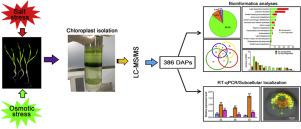Journal of Proteomics ( IF 2.8 ) Pub Date : 2021-01-02 , DOI: 10.1016/j.jprot.2020.104097 Dong Zhu 1 , Fei Luo 1 , Rong Zou 1 , Junxian Liu 1 , Yueming Yan 1

|
In this study, we performed an integrated physiological and chloroplast proteome analysis of wheat seedling leaves under salt and osmotic stresses by label-free based quantitative proteomic approach. Both salt and osmotic stresses significantly increased the levels of abscisic acid and methyl jasmonate and led to damages of chloroplast ultrastructure. Main parameters of chlorophyll fluorescence and gas exchange showed a significant decline under both stresses. Quantitative proteomic analysis identified 194 and 169 chloroplast-localized differentially accumulated proteins (DAPs) responsive to salt and osmotic stresses, respectively. The abundance of main DAPs involved in light-dependent reaction were increased under salt stress, but decreased in response to osmotic stress. On the contrary, salt stress induced a significant upregulation of the DAPs associated with Calvin cycle, transcription and translation, amino acid metabolism, carbon and nitrogen metabolism, and some of them exhibited a downregulation under osmotic stress. In particular, both treatments significantly upregulated the DAPs involved in plastoglobule development, protein folding and proteolysis, hormone and vitamin synthesis. Finally, we proposed a putative synergistic responsive network of wheat chloroplast proteome under salt and osmotic stresses, aiming to provide new insights into the underlying response and defense mechanisms of wheat chloroplast proteome in response to abiotic stresses.
Significance
Salt and osmotic stresses are the two most common abiotic stresses that severely affect crop growth and productivity. As the main site of photosynthesis of plant cells, the chloroplast also plays important role in plant tolerance to abiotic stress. However, the response of chloroplast proteome to salt and osmotic is still poorly understood by using the traditional two-dimensional electrophoresis (2-DE) method due to a poor resolution of chloroplast protein separation and low throughput identification of differentially accumulated proteins (DAPs). In this study, we employed label-free based quantitative proteomic approach to perform an integrated physiological and large-scale chloroplast proteome analysis of wheat seedling leaves under salt and osmotic stresses, which laid a solid foundation for future studies into the response and defense mechanisms of wheat chloroplast in response to abiotic stresses.
中文翻译:

盐和渗透胁迫下小麦幼苗叶片的生理和叶绿体蛋白质组综合分析
在这项研究中,我们通过基于无标签的定量蛋白质组学方法对盐和渗透胁迫下小麦幼苗叶片进行了生理和叶绿体蛋白质组综合分析。盐和渗透胁迫均显着增加了脱落酸和茉莉酸甲酯的含量,并导致叶绿体超微结构的破坏。在两种胁迫下,叶绿素荧光和气体交换的主要参数均显着下降。定量蛋白质组学分析分别确定了194和169个叶绿体定位的差异累积蛋白(DAP),分别响应盐和渗透胁迫。在盐胁迫下,参与光依赖性反应的主要DAP的含量增加,但对渗透胁迫的响应降低。反之,盐胁迫导致与加尔文循环,转录和翻译,氨基酸代谢,碳和氮代谢相关的DAP显着上调,其中一些在渗透胁迫下表现出下调。特别是,两种治疗均显着上调了质体球发育,蛋白质折叠和蛋白水解,激素和维生素合成中所涉及的DAP。最后,我们提出了盐和渗透胁迫下小麦叶绿体蛋白质组的假定协同响应网络,旨在为小麦叶绿体蛋白质组对非生物胁迫的潜在应答和防御机制提供新的见解。其中一些在渗透胁迫下表现出下调。特别是,两种治疗均显着上调了质体球发育,蛋白质折叠和蛋白水解,激素和维生素合成中所涉及的DAP。最后,我们提出了盐和渗透胁迫下小麦叶绿体蛋白质组的假定协同响应网络,旨在为小麦叶绿体蛋白质组对非生物胁迫的潜在应答和防御机制提供新的见解。其中一些在渗透胁迫下表现出下调。特别是,两种治疗均显着上调了质体球发育,蛋白质折叠和蛋白水解,激素和维生素合成中所涉及的DAP。最后,我们提出了盐和渗透胁迫下小麦叶绿体蛋白质组的假定协同响应网络,旨在为小麦叶绿体蛋白质组对非生物胁迫的潜在应答和防御机制提供新的见解。
意义
盐分和渗透胁迫是严重影响作物生长和生产力的两种最常见的非生物胁迫。作为植物细胞光合作用的主要场所,叶绿体在植物对非生物胁迫的耐受性中也起着重要作用。然而,由于叶绿体蛋白分离的分辨率差和差异累积蛋白(DAP)的低通量鉴定,通过使用传统的二维电泳(2-DE)方法,人们对叶绿体蛋白质组对盐和渗透的反应仍然知之甚少。在这项研究中,我们采用了基于无标签的定量蛋白质组学方法,对盐胁迫和渗透胁迫下小麦幼苗叶片进行了生理和大规模的叶绿体蛋白质组学综合分析,











































 京公网安备 11010802027423号
京公网安备 11010802027423号